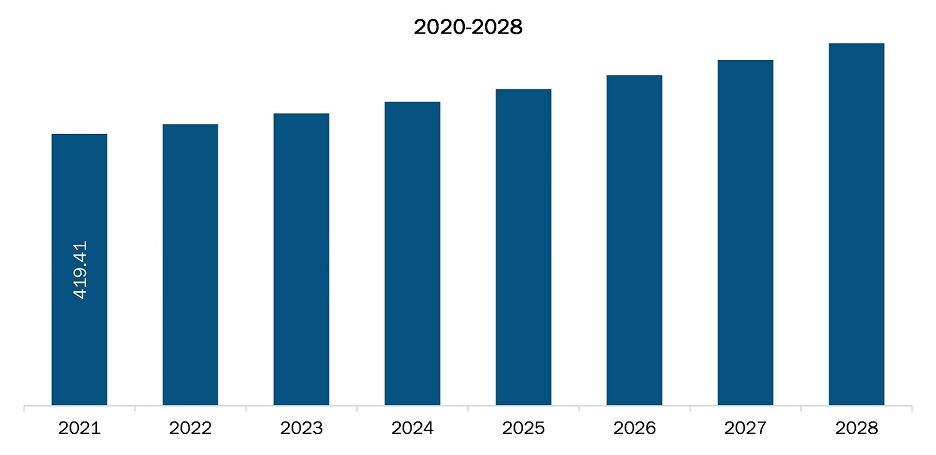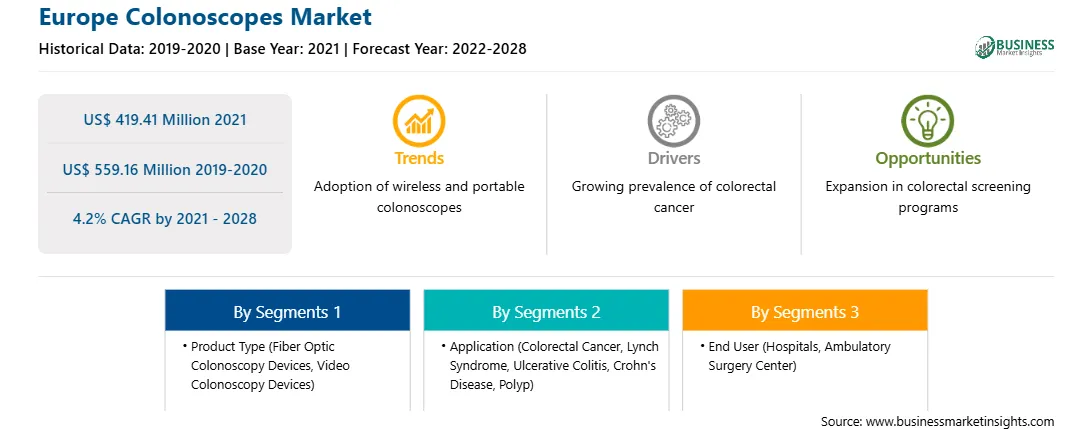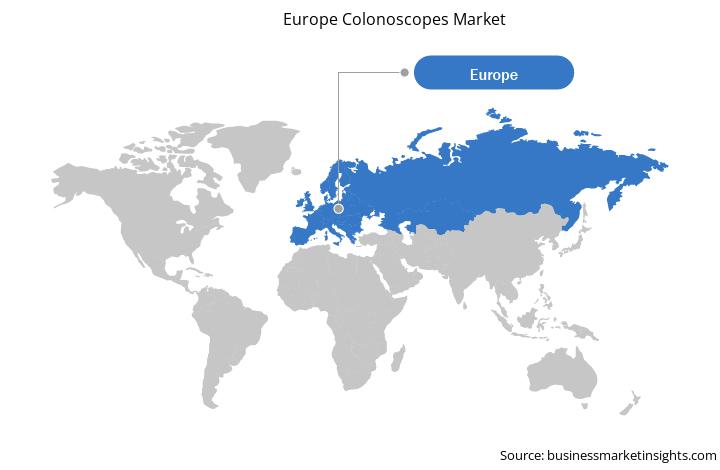Colonoscopes are used for the removal of foreign bodies, excision of tumors or colorectal polyps (polypectomy), and control of hemorrhage. Routine colonoscopy is important in diagnosing intestinal cancer, the second leading cause of cancer deaths in the United States. These endoscopic procedures reduce the need for invasive surgical diagnostic and therapeutic procedures.

Strategic insights for the Europe Colonoscopes provides data-driven analysis of the industry landscape, including current trends, key players, and regional nuances. These insights offer actionable recommendations, enabling readers to differentiate themselves from competitors by identifying untapped segments or developing unique value propositions. Leveraging data analytics, these insights help industry players anticipate the market shifts, whether investors, manufacturers, or other stakeholders. A future-oriented perspective is essential, helping stakeholders anticipate market shifts and position themselves for long-term success in this dynamic region. Ultimately, effective strategic insights empower readers to make informed decisions that drive profitability and achieve their business objectives within the market.

| Report Attribute | Details |
|---|---|
| Market size in 2021 | US$ 419.41 Million |
| Market Size by 2028 | US$ 559.16 Million |
| Global CAGR (2021 - 2028) | 4.2% |
| Historical Data | 2019-2020 |
| Forecast period | 2022-2028 |
| Segments Covered |
By Product Type
|
| Regions and Countries Covered | Europe
|
| Market leaders and key company profiles |
The geographic scope of the Europe Colonoscopes refers to the specific areas in which a business operates and competes. Understanding local distinctions, such as diverse consumer preferences (e.g., demand for specific plug types or battery backup durations), varying economic conditions, and regulatory environments, is crucial for tailoring strategies to specific markets. Businesses can expand their reach by identifying underserved areas or adapting their offerings to meet local demands. A clear market focus allows for more effective resource allocation, targeted marketing campaigns, and better positioning against local competitors, ultimately driving growth in those targeted areas.

The Europe colonoscopes market is expected to reach US$ 559.16 million by 2028 from US$ 419.41 million in 2021; it is estimated to grow at a CAGR of 4.2% from 2021 to 2028. A few factors such as the increasing prevalence of colorectal cancer, growing research activities to extend its applications in therapeutic areas, technological advancements in colonoscopy devices, and development of robotic colonoscopes are driving the growth of the market. However, the availability of alternative diagnostic tests for rectal diseases hampers the market growth.
The success rate of diagnosing colorectal conditions, including cancer, has increased with advancements in technologies. Flexible endoscopy is an effective method enabling the early diagnosis and treatment of gastrointestinal cancer, making it a popular choice for screening. However, a large population that benefits from endoscopic colorectal cancer screening feels skeptical about undergoing the procedure. This is mainly ascribed to psychological barriers due to the indignity of the process, fear of procedure-related pain, discomfort in bowel preparation, and potential need for sedation, which underlines an urgent need for new technologies for addressing these issues. To significantly reduce the adenoma “miss rate” of standard forward-viewing colonoscopy, manufacturers are continuously striving to improve the current colonoscopy techniques, by exploring more advanced optics and wider-angle visualization tools along with a user-friendly, intuitive endoscopic platform interface. The introduction of such technologies is fueling the colonoscope market growth. Also, March is marked as the National Colorectal Awareness Month, dedicated to encouraging patients, survivors, and caregivers to share their stories, advocate for colorectal cancer prevention, and inform others about the importance of early detection. Thus, growing awareness about the effect of colon disorders will increase the adoption of colonoscopy tests during the forecast period, thus offering lucrative opportunities to the market players.
Europe has been hit hard by an exponential increase in the number of COVID-19 cases and deaths, leading to congestion in the plumbing system and high infection rates among health professionals. The rising rate of confirmed cases is putting an increased burden on the region's healthcare system, which is propelling the demand for diagnostic tests in their healthcare system and supporting the expansion of the sector in the region. The colonoscope market suffered from a shortage at the beginning of the COVID-19 crisis due to the disruption in the supply chain and reduced demand due to the lockdown announced by most European countries. Market participants and end-users are losing their businesses due to the temporary closure of industries in various countries. The COVID-19 pandemic has hereby exposed the weaknesses and lack of resilience in European health systems, with severe consequences for cancer care and patients. Crucial attention is required to restore cancer care, and prepare for the challenges ahead like risk stratification, i.e., prioritizing cancer patients at higher risk according to cancer type, tumor type, or tumor stage. For instance, using fecal immunochemical tests (FIT) to identify patients at highest risk for developing colorectal cancer (CRC) and refer them to urgent colonoscopy to manage the reduced colonoscopy capacity best while ensuring rapid diagnosis and treatment of CRC. Based on the opinion of the European Society of Gastrointestinal Endoscopy and Endoscopy Nurse and Associates (ESGE-ESGENA), colonoscopies for colorectal cancer screening (CRCS) have been guaranteed at most referral centers and have been labeled as “high priority endoscopy procedures” in Europe.
The Europe colonoscopes market, by product type, is bifurcated into fiber optic colonoscopy devices and video colonoscopy devices. The fiber optic colonoscopy devices segment held a larger share of the market in 2021, and the same segment is anticipated to register a higher CAGR in the market during the forecast period.
The Europe colonoscopes market, based on application, is segmented into colorectal cancer, lynch syndrome, ulcerative colitis, crohn’s disease, and polyp. In 2021, the colorectal cancer segment held the largest share of the market. Also, the market for the same segment is expected to grow at the fastest rate in the coming years.
The Europe colonoscopes market, based on end user, is segmented into hospitals, ambulatory surgery center, and others. In 2021, the hospitals segment held the largest share of the market. Further, the market for the same segment is expected to grow at the fastest rate in the coming years.
A few of the primary and secondary sources referred to while preparing the report on the Europe colonoscopes market are the European Society of Gastrointestinal Endoscopy (ESGE), European Association of Urology (EAU), and Society of Gastroenterology Nurses and Associates (SGNA).
The Europe Colonoscopes Market is valued at US$ 419.41 Million in 2021, it is projected to reach US$ 559.16 Million by 2028.
As per our report Europe Colonoscopes Market, the market size is valued at US$ 419.41 Million in 2021, projecting it to reach US$ 559.16 Million by 2028. This translates to a CAGR of approximately 4.2% during the forecast period.
The Europe Colonoscopes Market report typically cover these key segments-
The historic period, base year, and forecast period can vary slightly depending on the specific market research report. However, for the Europe Colonoscopes Market report:
The Europe Colonoscopes Market is populated by several key players, each contributing to its growth and innovation. Some of the major players include:
The Europe Colonoscopes Market report is valuable for diverse stakeholders, including:
Essentially, anyone involved in or considering involvement in the Europe Colonoscopes Market value chain can benefit from the information contained in a comprehensive market report.